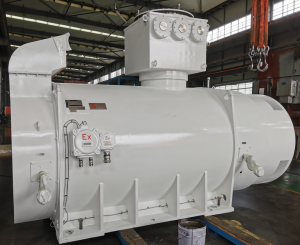In the world of three phase electric motors, especially wound rotor motors, shaft integrity is critical. A damaged shaft can cause catastrophic failure, resulting in costly downtime and repairs. To mitigate these risks, it is important to understand the various locations within the motor that may affect shaft integrity, including bearing locations, shaft extension locations, core locations, fan locations, and slip ring locations.
Bearing location
Bearing position is critical to maintaining shaft alignment and stability. Bearings support the shaft and allow it to rotate smoothly. If bearings are misaligned or improperly installed, uneven wear and excessive vibration can result. Over time, this can cause the shaft material to fatigue, leading to cracks or even complete breakage. Regular maintenance and precise bearing installation are essential to ensure bearings are in the correct position and functioning optimally.
Axis extension position
The shaft extension position refers to the part of the shaft that extends out of the 3 phase motor housing. This area often experiences additional stress, especially when it is connected to external components such as gears or pulleys. If the extension is too long or improperly supported, the bending moment may exceed the material limits of the shaft. This bending can initiate cracks that can propagate and cause shaft failure. Ensuring that the shaft extension is designed and supported correctly is critical to preventing breakage.
Iron core position
The position of the core within the motor plays an important role in overall magnetic field and torque production. If the cores are misaligned, uneven magnetic forces are created, causing vibrations. These vibrations can be transmitted to the shaft, causing stress concentrations that lead to fatigue and eventual fracture. Proper alignment of the core is essential to maintain a balanced magnetic field and minimize vibration, thereby protecting the shaft from excessive stress.
Fan location
Fan location is another key factor that affects motor cooling and operating efficiency. If the fan is misaligned or clogged, it can cause overheating and the shaft material can weaken over time. Excess heat can cause thermal expansion, causing shaft and bearing misalignment. This misalignment creates additional stress that may cause breakage. Ensuring that the fan is positioned correctly and operating efficiently is critical to maintaining optimal operating temperatures and protecting the shaft.
Wound rotor motor slip ring position
The position of the slip ring is especially important for wound rotor motors as it facilitates the transfer of power to the rotor. If the slip rings are misaligned, arcing and excessive wear can result, creating heat and vibration. These factors can lead to shaft misalignment and increased stress, ultimately leading to breakage. Regular inspection and maintenance of slip rings is essential to ensure they are in the correct position and functioning properly.
In summary
To sum up, the integrity of the central shaft of the three phase induction wound rotor motor is affected by several key positions, including the bearing position, shaft extension position, core position, fan position and collector ring position. Each of these elements plays a vital role in maintaining the overall health of your motor. By understanding potential links that may lead to shaft breakage quality issues, engineers and maintenance personnel can take proactive steps to ensure the longevity and reliability of wound rotor motors. Regular inspections, precise alignment and proper maintenance practices are critical to mitigating the risks associated with shaft breakage, ultimately improving performance and reducing downtime.
Post time: Oct-10-2024


